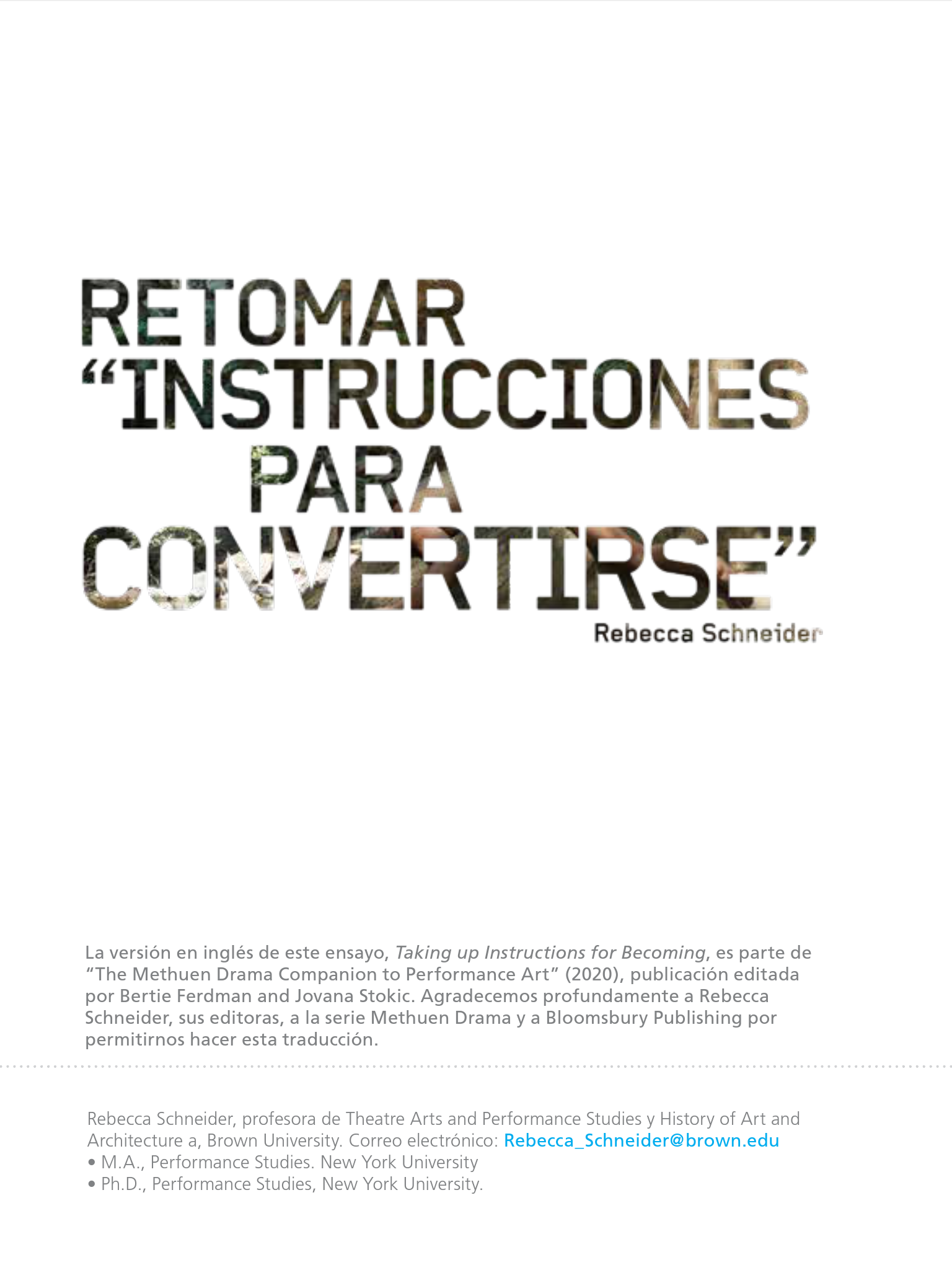
Publicado 2019-12-05
Palabras clave
- performance,
- decolonial,
- cuerpos,
- animado/inanimado,
- memoria
Cómo citar
Derechos de autor 2019 Rebecca Schneider

Esta obra está bajo una licencia internacional Creative Commons Atribución-NoComercial 4.0.
Resumen
Este ensayo analiza una serie de performance fotográficos de Emilio Rojas titulada Instrucciones para convertirse (2019). La serie de Rojas rinde homenaje a la artista Laura Aguilar y, pensando en el homenaje, este ensayo considera el gesto, así como al llamado y la respuesta, como técnicas de performance, mediante las cuales los cuerpos y las obras de arte saltan cuerpo a cuerpo, miembro a miembro. A través de otra obra de Rojas, Heridas Abiertas (A Gloria), el ensayo luego se mueve para discutir la obra Fringe, de la artista anishnaabe Rebecca Belmore, que se puede leer junto a la amalgama Rojas/Aguilar. La aparición de Belmore en el capítulo marca el comienzo de un trabajo que hace gestos hacia mundos ancestrales, en su caso indígenas, para presentar alternativas a la marcha miope de los registros del tiempo capital-colonial. Acto seguido, hago un contrapunto entre Viaje a Italia, de Roberto Rossellini, y lsa obras de Belmore, Aguilar y Rojas. La película de Rossellini, así como los performances de Rojas, Aguilar y Belmore, exploran el salto de la gestualidad entre materiales animados e inanimados, entre materiales humanos y no humanos, como son las estatuas de piedra y la carne humana o, en el caso de Rojas, las extremidades de los árboles y las extremidades humanas. El esfuerzo, en todo el ensayos, es producir una práctica de críticismo de performance decolonial.
Descargas
Citas
- Aguilar, L.(2015). Human Nature. Boom 5(2). http://bit.ly/2sGYLhj
- Anzaldúa, G.(1987). Borderlands, la Frontera. San Francisco: Aunt Lute Books.
- Barad, K.(2003). Posthumanist performativity: toward an understanding of how matter comes to matter. Signs 28(3), 801-831.
- Bergs, S.(2018). Material relations: Interview with Julia Bryan-Wilson. Open!: Platform for Art, Culture and the Public Domain (29 de mayo). http://bit.ly/2szkWFZ
- Caillois, R.(1935 [1984]). Mimicry and legendary psychasthenia, trad. J. Shepley. October 31, 12-32.
- Chen, MY.(2012). Animacies: Biopolitics, Racial Mattering, and Queer Affect. Durham, N.C.:Duke University Press.
- Chen, MY. y Luciano D (eds.).(2015). Dossier Queer Inhumanisms. Gay and Lesbian Quarterly 21 (2-3).
- Coulthard, GS.(2014). Red Skins, White Masks: Rejecting the Colonial Politics of Recognition. Minneapolis: University of Minnesota Press.
- Dean, Carolyn.(1999). Inka Bodies and the Bodies of Christ. Durham: Duke University Press.
- Derrida, J. y Vattimo, G.(1998). Religión. Palo Alto: Stanford University Press.
- Hartman, S.(2008). Lose Your Mother: A Journey Along the Atlantic Slave Route. Nueva York:Farrar, Strauss and Giraux.
- Hillier, J. (ed.).(1985). Interviews with Roberto Rossellini. Cahiers du Cinéma 1, 211.
- Mengesha, LG. y L. Padmanabhan (eds.).(2019). Special Issue Performing Refusal/Refusing to Perform. Women and Performance 29.
- Mignolo, W.(2005). The Idea of Latin America. Londres: Blackwell Publishing.
- Povinelli, EA.(2016). Geontologies: A Requiem to Late Liberalism. Durham, NC: Duke University Press.
- Schneider, R.(2011). Performing Remains: Art and War in Times of Theatrical Reenactment. Nueva York: Routledge.
- "”"”"”.(2015). New Materialism and Performance Studies. TDR: A Journal of Performance Studies 59, 2.
- "”"”"”.(2017). Intra-inanimations. En C. Braddock (ed.), Animism in Art and Performance, 191-212. Nueva York: Palgrave Macmillan.
- "”"”"”.(2018). Appearing to others as others appear: thoughts on performance, the polis, and public space. En A. Pais (ed.), Performance in the Public Sphere. Lisboa: Centro de Estudos de Teatro and Per Form Ativa. https://performativa.pt/
- "”"”"”.(2018b). that the past may yet have another future: gesture in the times of hands up. Theatre Journal 70(3), 285-306.
- Sharpe, C.(2016). In the Wake: On Blackness and Being. Durham, N.C.: Duke University Press.
- Simpson, L.(2011). Dancing on Our Turtle"™s Back: Stories of Nishnaabeg Re-creation, Resurgence, and a New Emergence. Winnipeg, Manitoba: Arbeiter Ring.
- Taussig, M.(1992). Mimesis and Alterity. Nueva York: Routledge.
- Taylor, D.(2003). The Archive and the Repertoire: Performing Cultural Memory in the Americas. Durham: Duke University Press.

